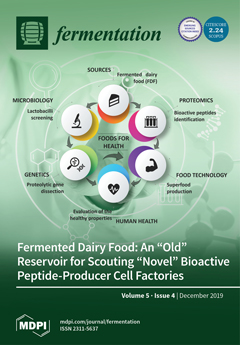This study demonstrates that the consortium, which consists of the microbial flora of methane production (MFMP) and
Clostridium cellulovorans grown with cellulose, can perform the direct conversion of cellulosic biomass to methane. The MFMP was taken from a commercial methane fermentation tank and
[...] Read more.
This study demonstrates that the consortium, which consists of the microbial flora of methane production (MFMP) and
Clostridium cellulovorans grown with cellulose, can perform the direct conversion of cellulosic biomass to methane. The MFMP was taken from a commercial methane fermentation tank and was extremely complicated. Therefore,
C. cellulovorans grown with cellobiose could not perform high degradation ability on cellulosic biomass due to competition by various microorganisms in MFMP. Focusing on the fact that
C. cellulovorans was cultivated with cellulose, which is armed with cellulosome, so that it is now armed
C. cellulovorans; the direct conversion was carried out by the consortium which consisted of MFMP and the armed
C. cellulovorans. As a result, the consortium of
C. cellulovorans grown with cellobiose and MFMP (CCeM) could not degrade the purified cellulose and mandarin orange peel. However, MFMP and the armed
C. cellulovorans reduced 78.4% of the total sugar of the purified cellulose such as MN301, and produced 6.89 mL of methane simultaneously. Furthermore, the consortium consisted of MFMP and the armed
C. cellulovorans degraded mandarin orange peel without any pretreatments and produced methane that was accounting for 66.2% of the total produced gas.
Full article





